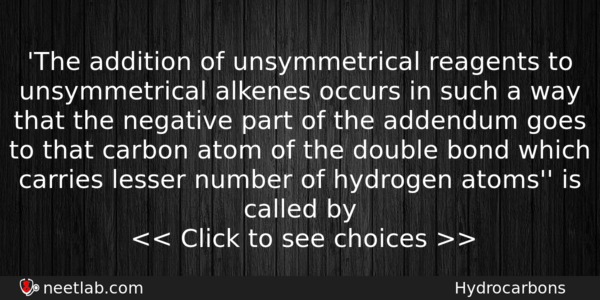| ⇦ | 
| ⇨ |
‘The addition of unsymmetrical reagents to unsymmetrical alkenes occurs in such a way that the negative part of the addendum goes to that carbon atom of the double bond which carries lesser number of hydrogen atoms” is called by
Options
(a) Saytzeff rule
(b) Markownikoff’s rule
(c) Kharasch effect
(d) Anti-Saytzeff rule
Correct Answer:
Markownikoff’s rule
Explanation:
No explanation available. Be the first to write the explanation for this question by commenting below.
Related Questions: - According to Dalton’s atomic theory the smallest partical of the matter is called
- Water softening by Clark’s process uses
- How many moles of iodine are liberated when 1 mole of potassium dichromate
- If Ksp for HgSO₄ is 6.4 x 10⁻⁵, then solubility of the salt is
- The number of hydroxide ions produced by one molecule of sodium carbonate
Topics: Hydrocarbons
(84)
Subject: Chemistry
(2512)
Important MCQs Based on Medical Entrance Examinations To Improve Your NEET Score
- According to Dalton’s atomic theory the smallest partical of the matter is called
- Water softening by Clark’s process uses
- How many moles of iodine are liberated when 1 mole of potassium dichromate
- If Ksp for HgSO₄ is 6.4 x 10⁻⁵, then solubility of the salt is
- The number of hydroxide ions produced by one molecule of sodium carbonate
Topics: Hydrocarbons (84)
Subject: Chemistry (2512)
Important MCQs Based on Medical Entrance Examinations To Improve Your NEET Score
18000+ students are using NEETLab to improve their score. What about you?
Solve Previous Year MCQs, Mock Tests, Topicwise Practice Tests, Identify Weak Topics, Formula Flash cards and much more is available in NEETLab Android App to improve your NEET score.
Share this page with your friends

Leave a Reply